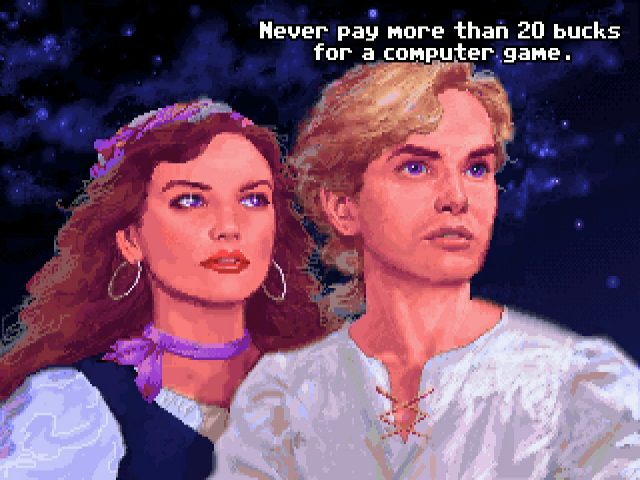The Secret of Monkey Island (TSMOI) Special Edition is the remastered version of the classic LucasArts point-and-click adventure game – Monkey Island 1. The series follows the goofy yet at times sassy Guybrush Threepwood on his way to becoming top-dog in the pirate world in the made-up Caribbean during the ever so romantic age of piracy. If you are a fan of one of the following: pirates, comedy, laughing, having fun or point-and-click adventures, then you should definitely pick this gem up, RIGHT NOW.
#9 Lens of the elemental Tetrad
Mechanics:
- In a point-and-click adventure game, players move around by clicking their mouse/ pressing a button on their controller. Where the character goes or what they interact with is governed by the cursor’s location on the screen.
- As with many other point-and-click adventure games, TSMOI offers the option for players to move around, initiate dialogues with NPCs, use items from the inventory and interact with objects in the scene.
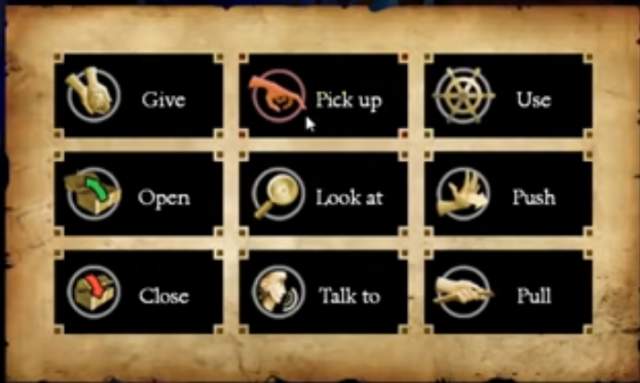
- While the base mechanics are generic, TSMOI is unique in its usage of these mechanics for its heavily themed minigames and puzzles. For example, TSMOI has managed to incorporate sword fighting – an essential part of pirate life, seamlessly into a game that only allows point-and-clicking. To avoid spoilers, I will only mention that this particular minigame requires the mechanics of a dialogue tree solely, yet, done so in such an ingenious way that it has become the most memorable part of the game among many fans. The minigames and puzzles will get more complicated over time, and the players will have to combine many of the basic point-and-click mechanics to make progress.
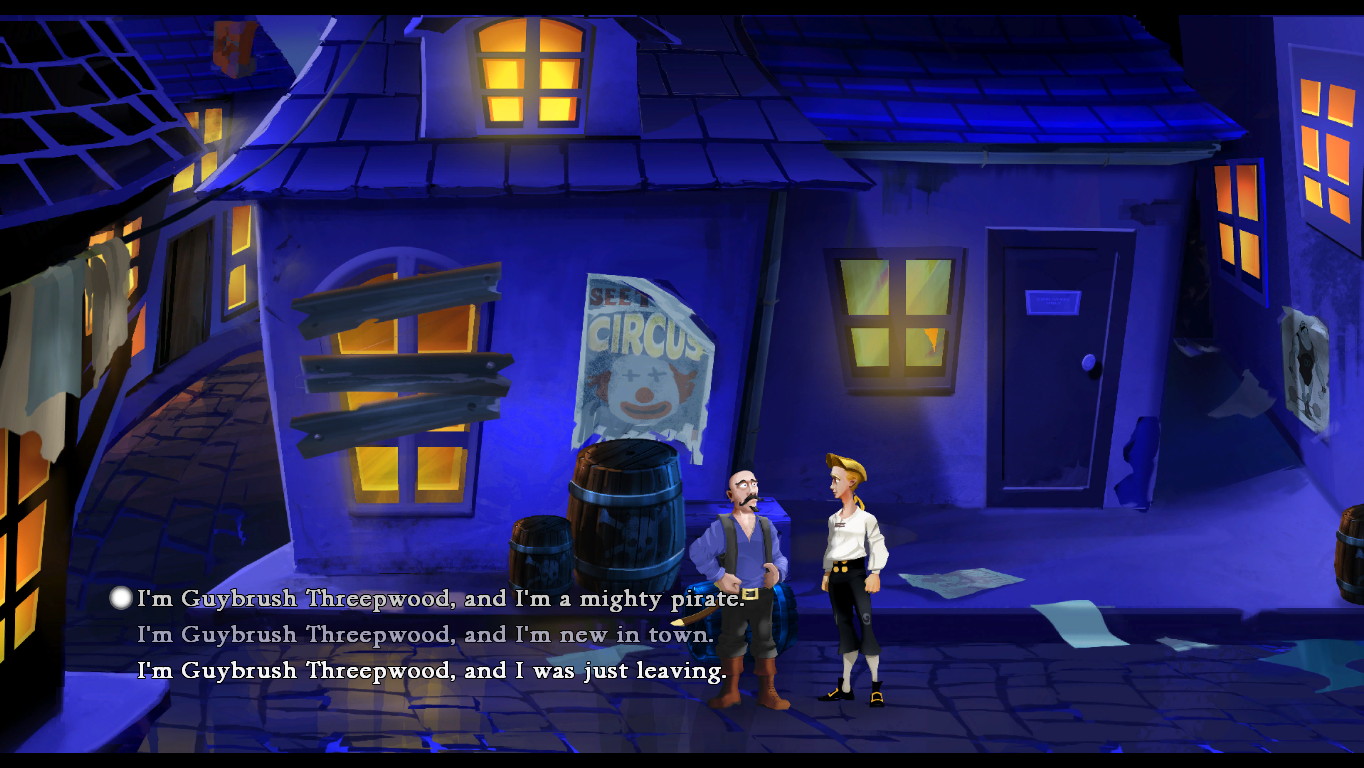
- There are also some notable mechanics improvements in the remaster. Firstly, pixel-by-pixel hunting is no longer in the game: the player will no longer have to slowly search every single pixel for a way out of a puzzle. This change is good design; puzzles will actually be puzzles instead of an eye test.
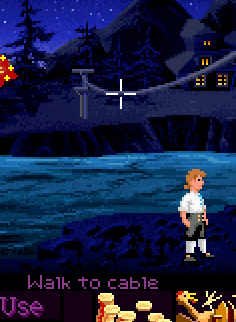
- Secondly, surprising deaths are not in the game. Most LucasArts point-and-click have never “condoned” deaths in their game. The death mechanic (in other point-and-click adventure games) used to scare players off exploring areas and dialogues or force them to be saving their games every 5 minutes of playtime. In either case, the mechanic imposes a terrible experience. In the former case, players would have missed out on so much fun content, and your (game designers >:( ) work have gone to waste for no reason! In the latter, stopping to save regularly causes boring downtime and disruption to the story’s immersion. The absence of these 2 mechanics in TSMOI adds to its attractiveness for point-and-click adventure games.
Aesthetics + Story:
- The game uses 2D graphics with beautifully drawn backdrops that give an illusion of a “depth” in the scene. In some scenes, the characters can navigate “into” the screen, an illusion caused by simple minimisation combined with walking animation.

- Scenes are coloured vibrantly, partly to help with puzzle-solving and partly to help with the romanticisation of the story, similar to the style of Pixar movies.

- The story is deemed “prescripted”, and you may think only the first playthrough is worth it. On the contrary, the animation and writings are done so elegantly that they always entice players back for a replay. Compared to the classic VGA version, besides the smoothening of polygons for a “HD” experience, this version has also cleaned up the user interface to better enjoy the drawn scene.
- A returning player who wants a blast from the past can switch to the endearing classic graphics at the press of a button!
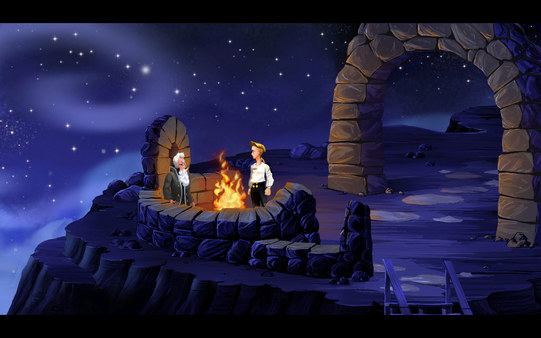
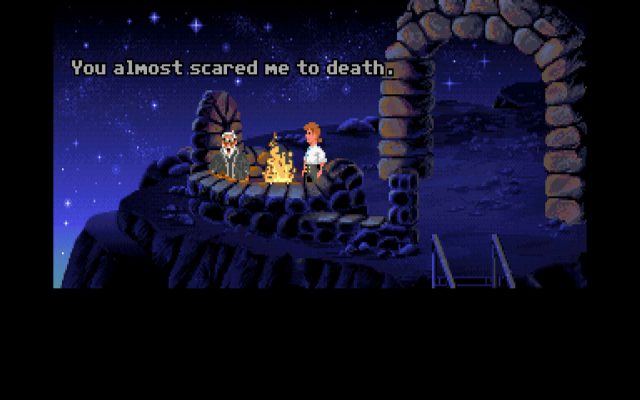
Technology: TSMOI has come a long way from 16-colour floppy disk support to 256-color CD-ROM support to now being shipped across many modern platforms and devices. With more storage space and modern hardware, the remastered version could insert beautiful voice acting and improved controls and audio. Players can now enjoy the story in many settings:
- Play and finish it on the PS3 with your best friend over a weekend sleepover (recommended!)
- Isolate yourself in a dark cosy room on your PC (WARNING: Sleeping schedule in danger!)
- Simply lean back on your vacation chair with the Ipad ($$).
#94 Lens of Atmosphere (atmosphere)
- The newly added voice acting has taken the writings of the dialogue to a new level. Characters personalities used to be subjected to the players’ interpretation through visuals. Now, the characters talk to the players with different pronunciations and tones. Pirates now sound more piraty, grumpy old man appears even grumpier, and Guybrush Threepwood sounds even more clumsy.
- The contrasts between the volumes of background music and the various pace at which each is composed trigger extremely effective perspective changes when the player enters scenes with different background tracks.
- The game relies heavily on interleaving cutscenes between puzzles as a mark of progress and a storyteller. With the cartoonish cinematics, the player will find themselves almost watching an interactive Disney blockbuster animated film.
#6 Lens of Curiosity
- TSMOI story isn’t profoundly creative, but there is always that lingering, annoying question that players will be pushed to finish the game: What on earth is the secret of the Monkey Island?
- Another contributor to curiosity is the massive bank of witty responses in the dialogue tree.
- Every character (to my knowledge) holds some kind of in-jokes or pop-culture references, and it is absolutely hilarious to find out what they have to say.
- The game is comedic, but the writing is so smartly fused with the story’s theme that the player doesn’t feel distracted. Instead of being tired by the humour, players look forward to seeing what the next new punchline will be.
- The curiosity to find out which actions work on which items, and the satisfaction when something finally gives, is what all TSMOI players subconsciously feel throughout the game.
#8 Lens of Problem Solving
- Since there are no “dead ends” compared to some other point-and-clicks, TSMOI’s puzzles are freer, more forgiving, and somewhat more manageable.
- The difficulty is well balanced and not utterly illogical that players still feel extremely accomplished after solving one without getting stuck for the whole day.
- The game ships with a “hint” function to help impatient players or simply for players to clarify that they have not encountered a bug. (Also, this is kind of the “easy mode”)
- The usage of the hint function is strongly discouraged personally. If you got your game legally, there is most certainly no bugs.
- In addition, there are no words for the feeling of finally realising the small details that you missed to finish the puzzle. You would probably feel so relieved and think to yourself, “Good one, LucasArts”. This is the essential experience that all TSMOI players should get.
- After solving “major” puzzles, players are rewarded with a cutscene, or various unforgettably majestic instrumentals marking their current progress in the game.
#86 Lens of Character Function
- Every character has a role, even the “background pirate A” archetypes.
- Expectedly, the “background” characters have less critical dialogues with more emphasis on jokes, while the more critical looking characters’ conversations are more developed and branched out.
- Most players will miss out on their first playthrough the hints/foreshadowing cleverly hiding behind the seemingly innocent humour of a “background” character. Every time you come back to the game, you notice more and more of these little details that you oversee due to frustrations from doing the puzzles.
TSMOI have managed to merge modern entertainment trends with contents written before most of us were born, creating a magical work of art that even the most cynical critics will close an eye on any mistakes found.
Every time you sit down and start the journey with Guybrush Threepwood, deep-down, you secretly hope to get stuck at a puzzle again; you wish the game would never end. You remember the dumb mistakes you make on the first playthrough, you see vividly what the developers have fascinated about the era of pirates, and you want to be part of that fantasy. Most importantly, you crave for the sequel so much that you can’t help replaying during the wait, and that, is what I call good game design.
